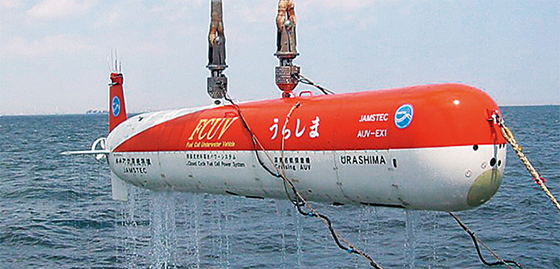After searching the international Mitsubishi Heavy Industries (MHI) website I located a civilian research (eg. JAMSTEC) (and perhaps dual-use naval) URASHIMA LDUUV (here) being developed by MHI (Photo above courtesy Mitsubishi Shipbuilding Co. Ltd).
Significantly URASHIMA is 10.7m long (meeting the 10m length requirement that the Japanese Ministry of Defense (MoD) set for large diameter unmanned undersea vehicle (LDUUV) development). Other specifications for URASHIMAare: 7.5 tonnes weight (surfaced), 3,500m max operating depth, 300km range, and 3 to 4 knots speed. Its likely diameter and known 10.7m length would make it too large for Japanese 533mm torpedo tubes. Hence attachment on top of a submarine hull or slide or crane delivery from a ship (as in photo above) may be necessary.
-------------------------------------------------------------------
Following Japanese Large Diameter Unmanned Underwater Vehicle (LDUUV) Developments, of November 27, 2018, Anonymous has commented, with further translation and [...] comments from Pete :
UUV technologies developed by Mitsubishi Heavy Industries (MHI) consist of:
i) i) low frequency acoustic sensors for the detection of buried mines on the ocean floor,
ii) ii) underwater navigation using autonomous positioning by matching ocean floor topography,
iii) iii) low speed, long endurance movement using lithium-ion batteries (LIBs),
iv) iv) underwater modeling and simulation by using sonars, and
v) v) an integrated launching tube.
Further development of UUV propulsion is required [eg. using LIBs and/or hydrogen-oxygen or other fuel cells] as well as development of communication methods and networks.
Tactical UUVs [perhaps torpedo tube launched] can be (or need to be) operated at relatively short distances and for short time periods remotely by an the operator [perhaps seated in a submarine].
In contrast [usually larger] strategic UUVs can autonomously operate for a longer period.
The Japanese MoD has successfully demonstrated fuel cells and underwater optical Wi-Fi (for communication at ranges up to 120m) for LDUUVs. [Sonobuoys, seabed line arrays and submarine-to-LDUUV wires may also be useful for LDUUV communications.]
See https://www.mhi.co.jp/technology/review/pdf/484/484012.pdf(it is in Japanese and there are useful pictures of:
- MHI’s probably torpedo sized UUV on page 12.
- the UUV network including parent or networked ships, subs, helicopters, patrol aircraft and sonobuoys on page 13.
- MHI’s probably torpedo sized UUV on page 12.
- the UUV network including parent or networked ships, subs, helicopters, patrol aircraft and sonobuoys on page 13.
- another photo and diagrams and graphs, pages 13 to 16.
There were also comments from /Kjell pointing to a Swedish language documenton Russian UUV developments. To which I responded “The Russians are also making great progress in the commercial (oil) and naval use of AUVs, specially in the Arctic Ocean and perhaps in the Sea of Japan.”
Drone Swarms
KQN also commented “There is no doubt that AI will have a key role in autonomous UUV and UUV swarms.” to which I responded “Indeed Artificial Intelligence (AI) (old similar concept "Autonomous") will indeed have roles in UUVs and UUV swarms. China in particular may mass produce small UUVs to form swarms, especially for deployment in highly strategic areas like the South China and East China Seas and Sea of Japan.”
The 2018 South Korean Winter Olympics illustrated what 2 operaters, who are computer controlling drone swarms, can do. Those "Olympic" drones are of course small Unmanned Aerial Vehicles. But from 40 seconds into the Youtube (through to 3 minutes) similar hardware and software capabilities also apply to UUVs finding and maybe attacking submarines and friendly UUVs.
